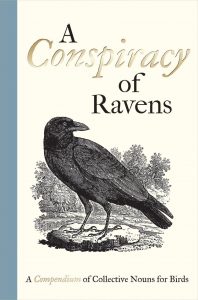 I’m starting a new series! About feathered folks! And not of the tarred & feathered variety, either!* To start off, we’re going to be exploring a bit the collective nouns we use for birds, which range from charming and witty to downright confusing.
I’m starting a new series! About feathered folks! And not of the tarred & feathered variety, either!* To start off, we’re going to be exploring a bit the collective nouns we use for birds, which range from charming and witty to downright confusing.
Do ravens come in unkindnesses or conspiracies? And why are we so biased against the nature of ravens, such that the sight of a group of them inspires either conspiracy or unkindness, or both? While this book won’t answer either of those questions – Fanous never addresses an unkindness of ravens, for example – it’s not quite the point of this delightful volume. I get the feeling that differences in collective nouns for different birds might be due in part to the fact that these collective nouns are not standardized, and are thus subject to the natural ebb and flow of the English language. Of course, there are the ones that enjoy pretty widespread use, such as a murmuration of starlings, or a murder of crows. Then there are the ones you might not have heard of before, that I’m pretty sure aren’t quite as ubiquitous: a conspiracy of ravens, for one (v.s. an unkindness), or a dropping of pigeons (I get the feeling someone got pigeon droppings on them after a group of pigeons flew overhead and coined this collective noun). Some are absolutely charming – a museum of waxwings is one such example, along with an invisibility of ptarmigans – while others incomprehensible – like how a group of herons is called a posse, but a flock of egrets is called a heronry. And then there’s the flock of bustards, which I can’t help but think got the short end of the stick, because they’re just entered into this compendium as a flock.
Another possibility is that – I’m wondering whether it’s because this compendium was published in the UK – perhaps there are geographical differences in collective nouns? To be honest, at this point, I’m getting the feeling there’s just more than one way to refer to a single-species mass of birds, for a number of species, and that maybe ravens are simply one of those that enjoy more than one (though I don’t know if they enjoy their reputation… it’s a bit less sinister than that for crows, I suppose, which have out and committed the murder already). Either way, you’ll be absolutely charmed by goldfinches, set a-trembling by finches, (apparently) inspired to conspire to unkindness by ravens, and probably left out of the heron posse (sadly). And I’ll be left wishing upon a star(ling) for someone to make this into a series of books of collective nouns, because I would be beyond ecstatic.
I haven’t talked about the illustrations yet, and I’d like to, but this is getting a bit long in the way of introduction to a series about birds, and I think taking the cover as the standard for the bird illustrations throughout will make for a fair evaluation. To keep it short: I’d love a poster of all these illustrations & accompanying text in my room, despite the fact that I don’t even put posters up in my room. I feel I might make an exception for this.
And now that those ravens have succeeded in their conspiracy to inspire you to read more about birds**, I’m going to provide a couple suggestions for general avian reading under the cut! Lily has also written a lovely post about Mozart’s Starling by Lyanda Lynn Haupt, where she has also listed a few avian recommendations, so go check out that post as well!

